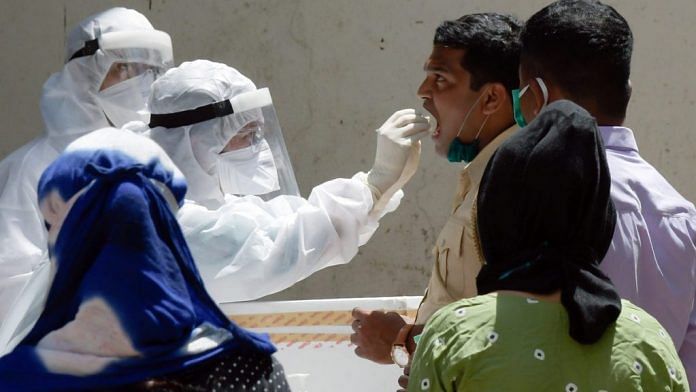New Delhi: A possible third wave of the Covid-19 pandemic in India is likely and it will peak between September and October this year, assuming India fully unlocks by 15 July, according to a prediction model by researchers at the Indian Institute of Technology-Kanpur. The team also noted that daily cases could peak at over 5 lakh cases a day in September, in the worst-case scenario.
The prediction model, however, does not take into account the effect of vaccinations in India, which the researchers say will have a significant impact on breaking the chain of transmission.
Using susceptible-infected-recovered (SIR) model — an epidemiological model that computes the theoretical number of people infected with a contagious illness in a closed population over time — three scenarios of a possible third wave using data from the second wave in India was constructed by the IIT Kanpur team, led by professors Rajesh Ranjan and Mahendra Verma.
The model assumes what would happen if India is fully unlocked on 15 July.
In the first scenario, where restrictions are lifted, the team predicts that the third wave will peak in October. However, this peak height will be lower than that of the second wave. At the peak, a maximum of 3.2 lakh cases will be recorded daily.
In the second scenario, the researchers assume the emergence of new, more infectious variants of SARS-CoV-2. If there are no lockdowns or restrictions, the peak could be higher than the second one and may appear earlier, in September. This is the worst-case scenario where the number of new infections on a daily basis could reach as high as 5 lakh a day.
The researchers predict a third scenario where the peak of the third wave could be delayed until late October. The model suggests if stricter interventions to prevent the spread of the disease are implemented, the peak of the third wave will be lower than the second wave, with less than 2 lakh cases reported in the worst case.
All three scenarios, however, predict a peak bigger than the first wave.
Also read: Over 13.7 lakh doses in a day — Andhra created a record even before India vaccinated 85 lakh
Limitations of the model
One of the limitations of the SIR model is that it assumes that the entire population is equally susceptible to the virus, and that is it does not take into account the effect of vaccinations.
It also assumes that the population is ‘closed’ — there is no migratory flow in or out so that changes in the population occur through births and deaths only.
“Vaccination is known to break the transmission chain. At present, the model does not include vaccination, which should decrease the peak significantly. Revised model with vaccination and with more recent data on the same is being worked out,” the researchers said.
The IIT Kanpur team has also been providing daily Covid-19 forecasts in India.
According to them, the second wave has waned significantly almost everywhere except in some states in the Northeast, such as Mizoram, Manipur and Sikkim.
As of Tuesday, India recorded 42,640 new cases of Covid across the country. At its peak in May, the country was reporting about 4 lakh cases daily.
While India’s test positivity has dropped to 2.6 per cent at present, the researchers said there is significant anxiety among policy makers and the public about the third wave.
Also read: What shocking data on Covid second wave deaths really reveals: Yogendra Yadav






